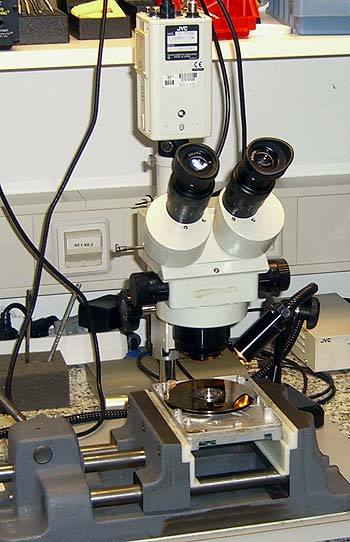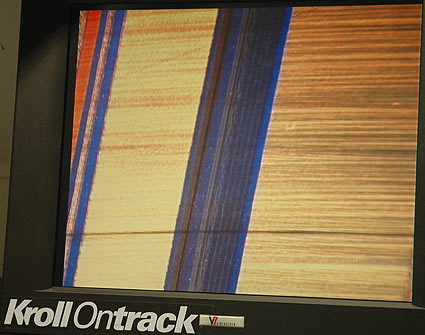RAID Recovery: The Data Knight Kroll Ontrack To The Rescue!
Follow-Up Analysis: Microscopic Approach On How To Find The Actual Problem
After data recovery, there is no reason to use the defective drive anymore, right? So most of the time it makes sense to perform an analysis to determine the cause of the faulty drive. Kroll Ontrack conducts its analysis under the microscope. The drive will be opened in the clean room, where a technician can apply a contrast liquid drop by drop onto the platter so magnetism can be seen under the microscope.
The black line illustrates one or more completely deleted data tracks, in this case due to overvoltage at the read/write heads resulting in immediate destruction of the magnetic areas. Indicated blue is the servo track, laid out concentric to the center of the platter. Modern hard drives have a multi-partitioned servo track due to its longer exterior track size.
Conclusion: Save Time And Money - Back Up Your Files
If you want to save a lot of time, money and trouble, perform regular backups. Data and malfunction analysis starts at $120 and can go up to $500; the actual data recovery will easily eat up $ 1,000 or more. Knocking on Kroll Ontrack's door with a broken RAID array might cost you as much as several thousand dollars. If you are willing to pay enough, data recovery is even possible on a RAID 5 array with two defective drives.
Even if you take good care of your hardware and do have a master strategy on how to secure it, there is always the chance that something goes wrong. If this happens, remember to remain calm! Overreacting might do more harm to your data than the malfunction itself. Keep your composure and don't start looking for a solution on your own, just because your boss might have a fit. Staying calm and discussing further action with competent people will give you the best results.
If you rely on data that might be lost and are not sure what to do, simply contact a data recovery specialist. Trying to saving a few bucks with a do-it-yourself rescue that goes wrong might cost you more nerves in the long run.
Join our discussion on this topic
Get Tom's Hardware's best news and in-depth reviews, straight to your inbox.
Current page: Follow-Up Analysis: Microscopic Approach On How To Find The Actual Problem
Prev Page Increasing The Level Of Difficulty: RAID Recovery
Patrick Schmid was the editor-in-chief for Tom's Hardware from 2005 to 2006. He wrote numerous articles on a wide range of hardware topics, including storage, CPUs, and system builds.
-
We strongly suggest you not use any data recovery software on your own unless you are a professionalReply
Instead, use a reliable RAID recovery company to extract the data for you
RetroData offer a money back guarantee!

